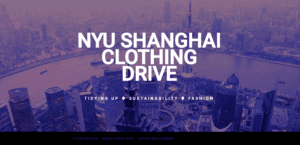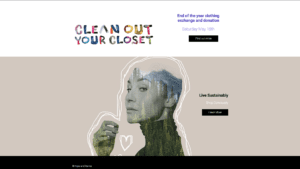Aurelia Vanelly Garces
Week 1: Exploitation
Anti-Fashion: A Manifesto for the Next Decade
Within two minutes of Li’s talk I instantly felt connected to the message she was beginning to give. We are shifting as creators and becoming more and more collaborative and open-minded. However, most fashion houses and the industry in general are very much stuck in this 20th century mindset. Personally, I have witnessed this multiple times when working with fashion houses myself. It’s beyond frustrating to know that the ideal of collaborative work is still not accepted. As Edelkoort’s continues her talk she mentions the concept of “shared-clothes”, the idea that we are beginning to “rent clothes, share clothes, lend clothes, transform clothes”. That Gen Z kids will only spend ⅓ of their money on clothes, that this is why we have to bring the idea of sustainability to the forefront. As generations are beginning to be more and more aware of what they consume, we as creators have to be more transparent with what we do.
Slow Fashion: An Invitation for Systems Change
I was always struggled with getting a true understanding of what fast and slow fashion truly meant. After reading Fletcher’s work I discovered more than just connecting fast fashion to brands like Fashion Nova who I should not be purchasing clothes from. I was able to get the idea that “fast” is not always bad, that it’s not just about companies that are producing at high volumes but rather it is a form of economic growth. Fletcher also discusses this new initiative on systems beginning to change. She states, “Ideas of slow culture are part of a bigger story of change and transformation in the fashion sector towards sustainability”. In order for us to move towards this we need to stray away from associating certain words and ideas to fast and slow fashion but rather get educated and get into a deeper understanding of what we can do to live in a more sustainable world.
The Hidden Lives of Domestic Things: Accumulations in Cupboards, Lofts and Shelves
When thinking of “hoarding”, I think of shows like Hoarders on Lifetime that give you a look into people who live in spaces that resemble junkyards. Just items and items that look like they have no reason to consume so much space. However, as I begin to read The Hidden Lives of Domestic Things I learn that for starters I should not judge someone by the amount of things they have collected but rather how we can learn from this. One of the biggest take aways from this chapter is the section “Wardrobes as a method: Looking at Accumulations and Assemblages of Things”. Woodward talks about how although this method has not been quite formulated and practiced we can learn a lot from being more mindful in the relationship we have with our things. This reminds me a lot of Marie Kondo, who has her show on Netflix that talks about how if something does not “spark joy” that we need to throw it out. Although the show does not tackle much of a “sustainable” approach if we were to tie this and with what Woodward brings up about the importance of relationships it could have an interesting approach.
Week 2: Research Approach I Ethnography in Practice
Short-Term Ethnography: Intense Routes to Knowing
In Short-Term Ethnography: Intense Routes to Knowing, Pink and Morgan discuss how informed ethnography is beginning to be be a more efficient way that “lead to deep and valid ways of knowing”. Personally, I find this to be more effective, given that I agree how long-term ethnography tends to be a lot of waiting for things to happen.Whereas the approach that is offered in this text means we have the ability to have a bit more legroom than long-term ethnography. Having the ability to approach participants and get a better insight than just observing.
The Life-Cycle of the Fashion Garment and the Role of Australian Mass Market Designers
Alicia Payne brings up the topic of how to properly assess the the life-cycle of a garment and how it matters in the perspective of a sustainable environment. This is something that I found very interesting and had me rethink of my clothing purchases, given the way in which clothing can last and how fibres and textile matter a lot more than they are explained to do so. It makes one become that more interested and wanting to be more aware of every aspect that goes into producing our clothing. This reminds me of Li Edelkort’s talk on how she explained that Generation Z and generations after are becoming more and more aware of what is really being produced. This being said, the discussions are far from over and with the help of Alicia Payne and Li Edelkort’s there is potential to do better as an industry.
Week Three: Business of Fashion I Design & Development
Eco-tech Fashion: Rationalizing Technology in Sustainable Fashion
It’s no surprise that technology and fashion go hand and hand. In a time where AI and 3D printing is at its peak, the industry has shifted into taking advantage of how far we have come. Again, as Scaturro explains this is not new for the two to be so aligned yet not always in a positive light. However, this is beginning to change now that companies are beginning to get behind the idea of being sustainable. Scaturro states, “Other digital options for purchasing ethical clothing besides online boutiques include real-time exchange venues”. This meaning taking advantages of websites like eBay. Also, websites like Rent the Runway do a stellar job on connecting technology with sustainability. Ideally, eco-fashion has the ability to make a vast difference in this industry it’s just a matter of how we can get to these solutions.
User-Centered Innovation: Design Thinking and Sustainability
Week Four: Business of Fashion I Sustainability Frameworks
Building a Sustainable Company: The Story of Eileen Fisher
Eileen Fisher is no stranger to sustainable fashion, a true pioneer in doing anything and everything to get her designs to be good for the environment while creating minimalistic looks. It’s admirable to see the work she has done and even taking advantage of technological advancements to create work that is customizable too. After reading this text, I became aware of how much textile industries waste water. For EF to aim on controlling how much they use is great to hear and makes me interested in seeing if the company will be able to reach their 2020 goal. It’s one of those things that even if it is not attainable the fact that Fisher is trying to achieve makes its something great. Not my companies are putting in this form of effort and to see what is being done makes one want to be more cautious on all aspects of purchasing.
Designing for the Circular Economy: Cradle to Cradle Design
Week Five: Business of Fashion | Sustainable Consumption Behaviour & Practices
Sustainable Consumer Behavior: Literature Overview
It’s easy for us to throw the word “sustainable” to anything and everything. However, Elena Kostadinova gives a clear overview of what this actually means in consumer behavior and how we can actually consume positively. Everything from research on consumer behavior to how to measure behavior and attitudes. It’s interesting to read just how influenced we are by things and how are behavior can quickly change. For instance, I always understood what sustainability meant yet it was not until I took this course as well as was added into WeChat groups about living a more “green” life that I began to really take in interest in things. However, as Kostadinova explains, “Achieving lasting behavioral change is undoubtedly one of the biggest challenges sustainability and limiting environmental degradation are facing” (231). We can always be conscious of what we are doing, but it’s a matter of us actually changing our daily behaviors.
China’s Sustainable Fashion Paradox
China has always been in the forefront of the large amount of negative consumption and non-sustainable ways it takes. However, we are at a point where consumers are beginning to wanting their brands to be more transparent and this is beginning to happen with Chinese consumers as well. As Hall states, “While a lot more awareness and education is needed, consumers are gradually waking up to the impact of fashion consumption”. There are many young creators who are trying to bring sustainability to the forefront in China, and although it may be difficult to do so there are tons of groups and brands specifically in Shanghai who are trying to break through. It will be interesting to see how SFW comes along later this month and if there are brands who are taking the step forward rather than back.


